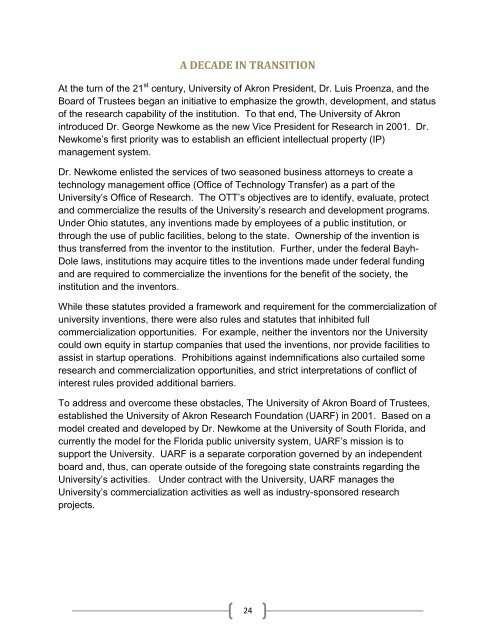10 Year Review - The University of Akron
10 Year Review - The University of Akron
10 Year Review - The University of Akron
Create successful ePaper yourself
Turn your PDF publications into a flip-book with our unique Google optimized e-Paper software.
A DECADE IN TRANSITION<br />
At the turn <strong>of</strong> the 21 st century, <strong>University</strong> <strong>of</strong> <strong>Akron</strong> President, Dr. Luis Proenza, and the<br />
Board <strong>of</strong> Trustees began an initiative to emphasize the growth, development, and status<br />
<strong>of</strong> the research capability <strong>of</strong> the institution. To that end, <strong>The</strong> <strong>University</strong> <strong>of</strong> <strong>Akron</strong><br />
introduced Dr. George Newkome as the new Vice President for Research in 2001. Dr.<br />
Newkome’s first priority was to establish an efficient intellectual property (IP)<br />
management system.<br />
Dr. Newkome enlisted the services <strong>of</strong> two seasoned business attorneys to create a<br />
technology management <strong>of</strong>fice (Office <strong>of</strong> Technology Transfer) as a part <strong>of</strong> the<br />
<strong>University</strong>’s Office <strong>of</strong> Research. <strong>The</strong> OTT’s objectives are to identify, evaluate, protect<br />
and commercialize the results <strong>of</strong> the <strong>University</strong>’s research and development programs.<br />
Under Ohio statutes, any inventions made by employees <strong>of</strong> a public institution, or<br />
through the use <strong>of</strong> public facilities, belong to the state. Ownership <strong>of</strong> the invention is<br />
thus transferred from the inventor to the institution. Further, under the federal Bayh-<br />
Dole laws, institutions may acquire titles to the inventions made under federal funding<br />
and are required to commercialize the inventions for the benefit <strong>of</strong> the society, the<br />
institution and the inventors.<br />
While these statutes provided a framework and requirement for the commercialization <strong>of</strong><br />
university inventions, there were also rules and statutes that inhibited full<br />
commercialization opportunities. For example, neither the inventors nor the <strong>University</strong><br />
could own equity in startup companies that used the inventions, nor provide facilities to<br />
assist in startup operations. Prohibitions against indemnifications also curtailed some<br />
research and commercialization opportunities, and strict interpretations <strong>of</strong> conflict <strong>of</strong><br />
interest rules provided additional barriers.<br />
To address and overcome these obstacles, <strong>The</strong> <strong>University</strong> <strong>of</strong> <strong>Akron</strong> Board <strong>of</strong> Trustees,<br />
established the <strong>University</strong> <strong>of</strong> <strong>Akron</strong> Research Foundation (UARF) in 2001. Based on a<br />
model created and developed by Dr. Newkome at the <strong>University</strong> <strong>of</strong> South Florida, and<br />
currently the model for the Florida public university system, UARF’s mission is to<br />
support the <strong>University</strong>. UARF is a separate corporation governed by an independent<br />
board and, thus, can operate outside <strong>of</strong> the foregoing state constraints regarding the<br />
<strong>University</strong>’s activities. Under contract with the <strong>University</strong>, UARF manages the<br />
<strong>University</strong>’s commercialization activities as well as industry-sponsored research<br />
projects.<br />
24
















